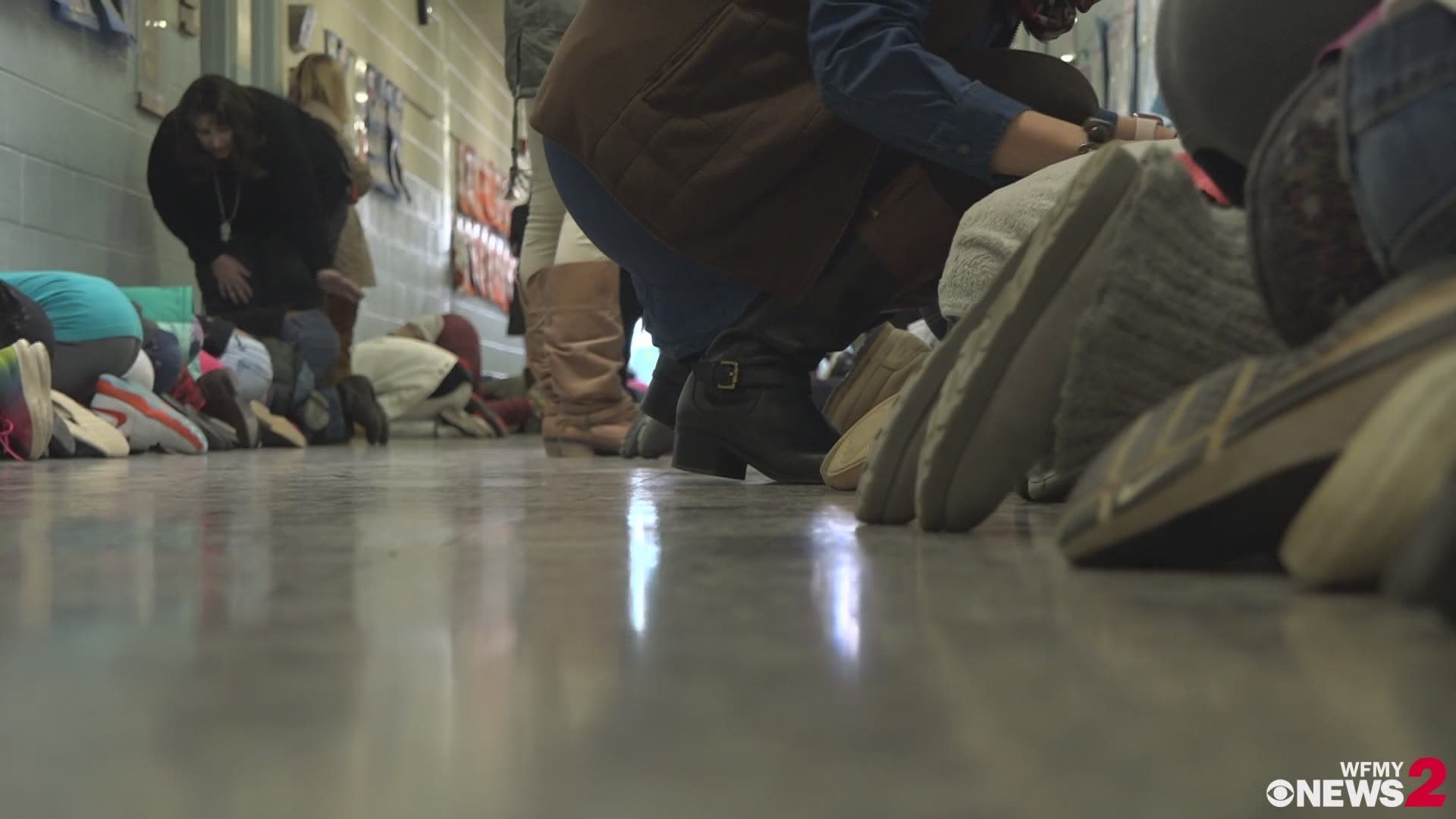GREENSBORO, NC -- Severe weather becomes more likely during the Spring, and you need to be ready. This week marks Severe Weather Preparedness Week in North Carolina.
Now is the time for you and your family to revisit your severe weather plan and make sure you're ready should tornadoes, flash floods, or high winds strike. While severe weather can happen at any point of the year, most of our tornadoes happen between March and May.

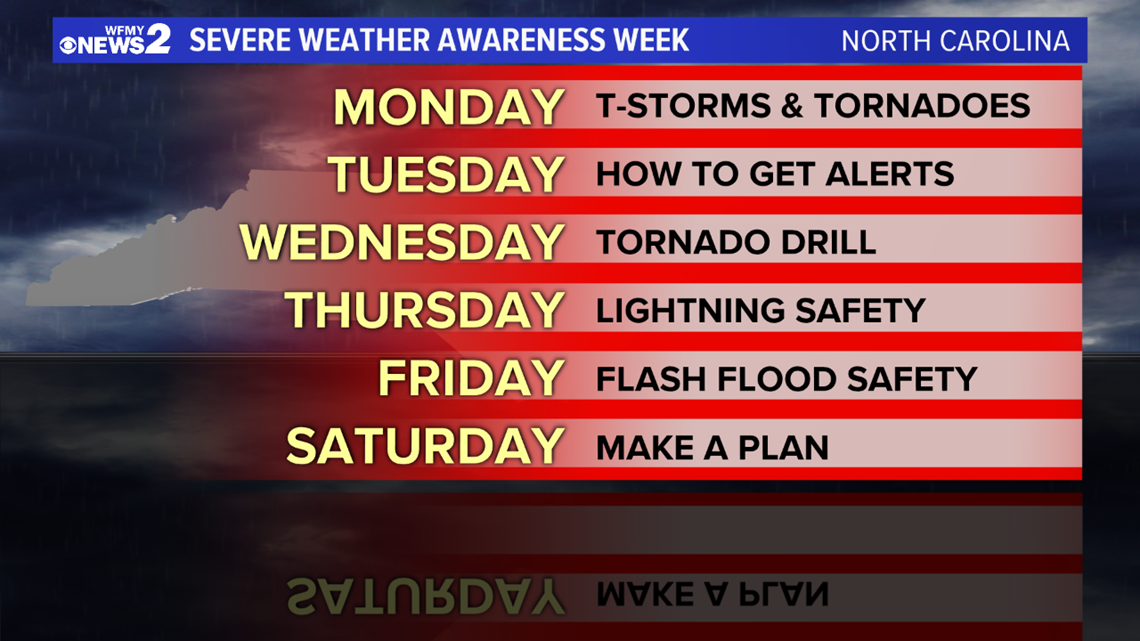
Each day this week, we'll be bringing you new information about a different severe weather topic.
MONDAY: Severe Thunderstorms and Tornadoes
Both thunderstorms, and tornadoes become more likely during the spring months. North Carolina experiences about 40 to 50 thunderstorm days per year. About 10 percent of thunderstorms are classified as severe – one that produces hail at least an inch in diameter, has winds of 58 miles per hour or stronger, or produces a tornado.

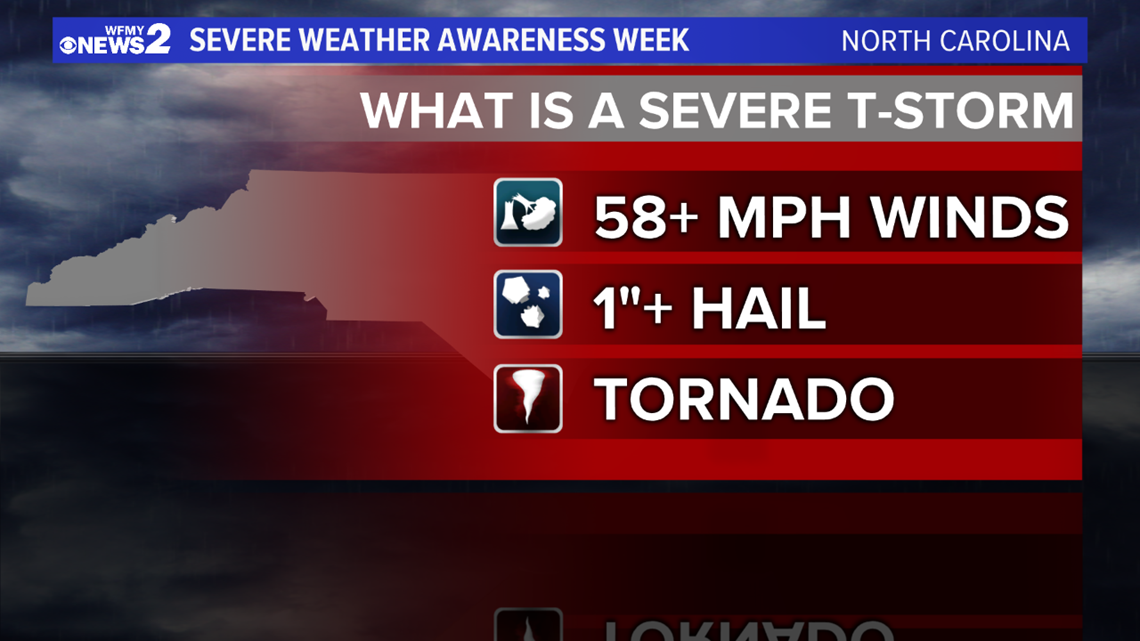
Tornadoes are nature’s most violent storms. Spawned from powerful thunderstorms, tornadoes can cause fatalities and devastate a neighborhood in seconds. A tornado appears as a rotating, funnel-shaped cloud that extends from a thunderstorm to the ground with whirling winds that can reach 300 miles per hour. Some tornadoes are clearly visible, while rain or nearby low-hanging clouds obscure others. Sometimes, tornadoes develop so rapidly that little, if any, advance warning is possible.

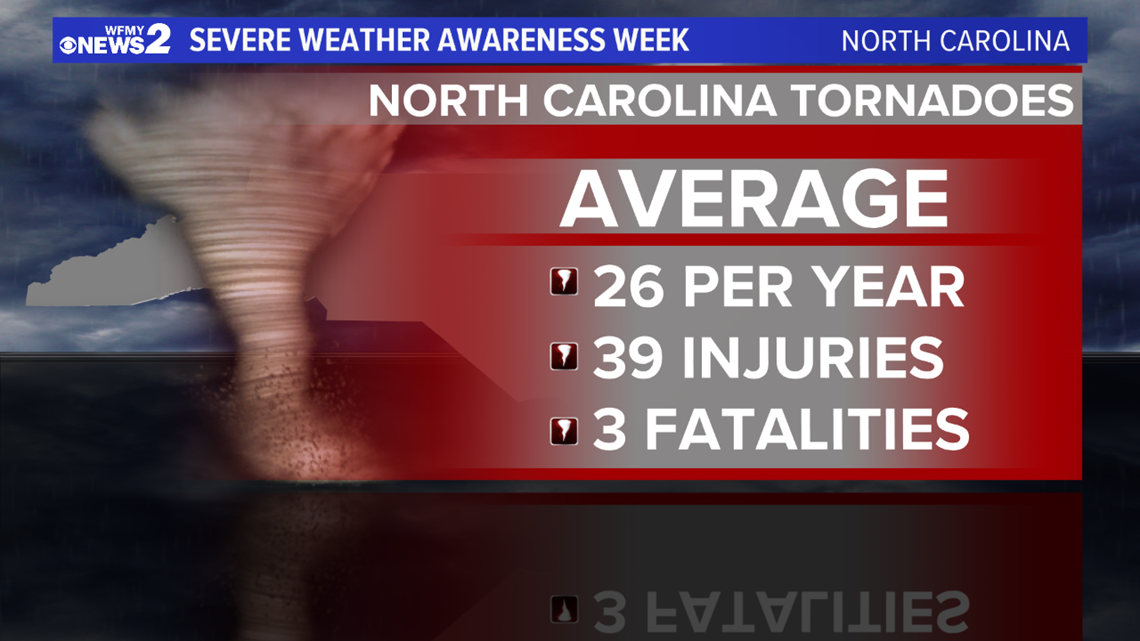
North Carolina averages 26 tornadoes, 3 tornado fatalities, and 39 tornado injuries each year. These tornadoes are most likely during the spring months, but they are also possible again during the fall.

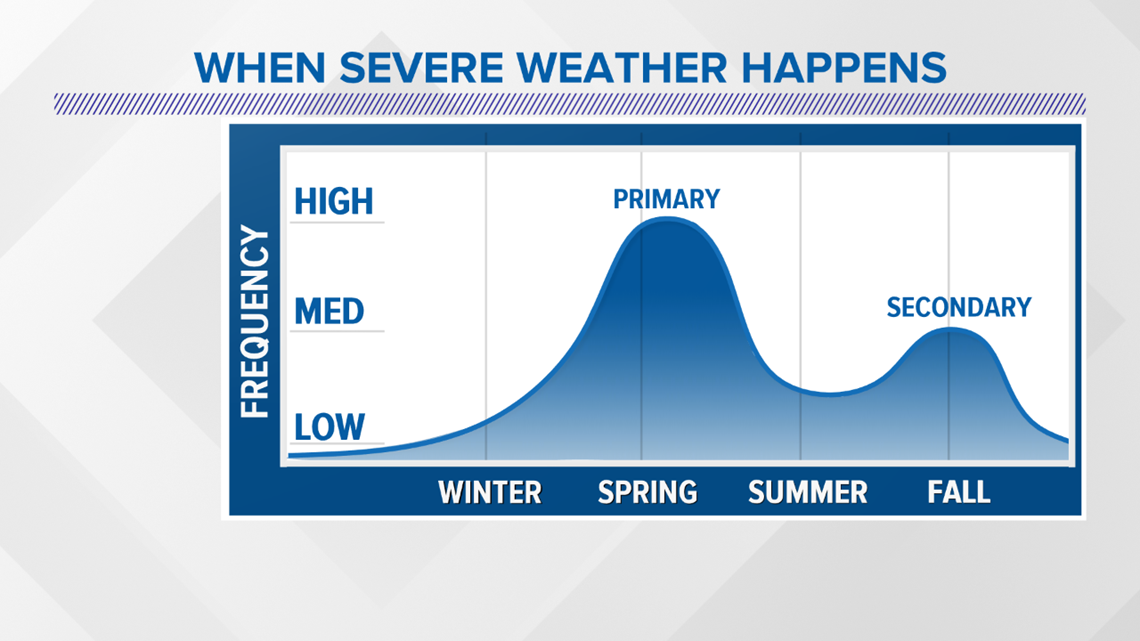
When severe weather becomes likely, the National Weather Service will issue either a Severe Thunderstorm Watch or a Tornado Watch. A Tornado Watch means that tornadoes are possible. During Tornado Watches, you should remain alert for approaching storms, watch the sky, and stay tuned to NOAA Weather Radio, commercial radio or television for additional information. A Tornado Warning means that a tornado has been sighted or indicated by weather radar. When a Tornado Warning is issued for your area, you should take shelter immediately.
Know the difference between a severe weather WATCH and a WARNING
- A WATCH means severe weather is possible, but not yet happening. Keep checking up on the weather throughout the day, have a plan ready in case warnings are issued for your area.
- A WARNING means severe weather is happening in your area. Seek shelter, and get to a safe place.
Of course, watches and warnings are only important if you know how to receive them.
Severe weather warnings can save your life. When dangerous weather is on the way, the National Weather Service will issue warnings, and there are several places you can get this life saving information.
The best ways to get severe weather alerts include, a NOAA Weather Radio, Wireless Emergency Alerts, your WFMY News 2 App, and on-air on WFMY News 2.
- NOAA Weather Radio: Think of this as a "smoke detector" for severe weather alerts. A weather radio can be purchased cheaply, and will sound in the event that a warning is issued for your area. At night, this will wake you up so your family can get to a safe place.
- Wireless Emergency Alerts: Most smart phones are enabled with Wireless Emergency Alerts. Make sure these are enabled by going into your notification settings. This will sound an alarm when a warning is issued for your area.
- WFMY News 2 App: The WFMY News 2 will send you severe weather alerts, but you need to make sure to enable these and set your specific location. See the video in this story for instructions.
- WFMY News 2: You can get the latest severe weather info by turning on WFMY News 2 on your TV. If the weather becomes truly dangerous, like a tornado warning, we'll broadcast continuously until the threat has passed.

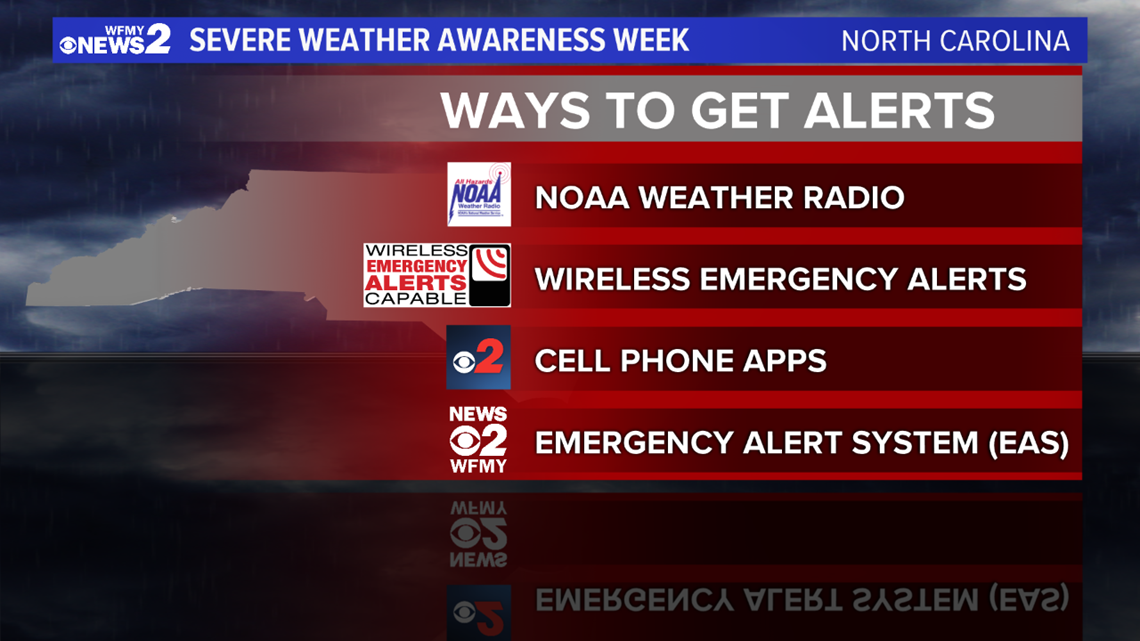
When your area is under a tornado warning, or if you see a tornado approaching, you should
seek shelter immediately! Most injuries associated with high winds are from flying debris, so
remember to protect your head. The following are safety tips for seeking shelter during high
winds and tornadoes.
If you are in a structure such as a residence, small building, school, nursing home, hospital,
factory, shopping center, or high-rise building:
- Go to a pre-designated area such as a safe room, basement, storm cellar, or the lowest building level. If there is no basement, go to the center of a small interior room on the lowest level (such as a closet, bathroom, or interior hallway) away from corners, windows, doors, and outside walls. Put as many walls as possible between you and the outside. Get under a sturdy table and use your arms to protect your head and neck.
- In a high-rise building, go to a small interior room or hallway on the lowest floor possible.
- Do not open windows.
If you are in a manufactured home or office:
- Get out immediately and go to a pre-identified location such as the lowest floor of a sturdy nearby building or a storm shelter. Mobile homes, even if tied down, offer little protection from tornadoes.
- If you are outside with no shelter available, there is no single research-based recommendation for what last-resort action to take, because many factors can affect your decision.
Possible actions include:
- Immediately get into a vehicle, buckle your seat belt and try to drive to the closest sturdy shelter. If your vehicle is hit by flying debris while you are driving, pull over and park and cover your head with your arms and a blanket, coat or other cushion if possible.
- Lie in an area noticeably lower than the level of the roadway and cover your head with your arms and a blanket, coat or other cushion if possible.
- Do not get under an overpass or bridge. You are safer in a low, flat location.
- Never try to outrun a tornado in urban or congested areas in a car or truck. Instead, leave the vehicle immediately for safe shelter.
Lightning Safety
Each year in the United States, more than 400 people are struck by lightning. On average, between 55 and 60 people are killed; hundreds of others suffer permanent neurological disabilities. Most of these tragedies can be avoided with a few simple precautions. When thunderstorms threaten, get to a safe place. Lightning safety is an inconvenience that can save your life.

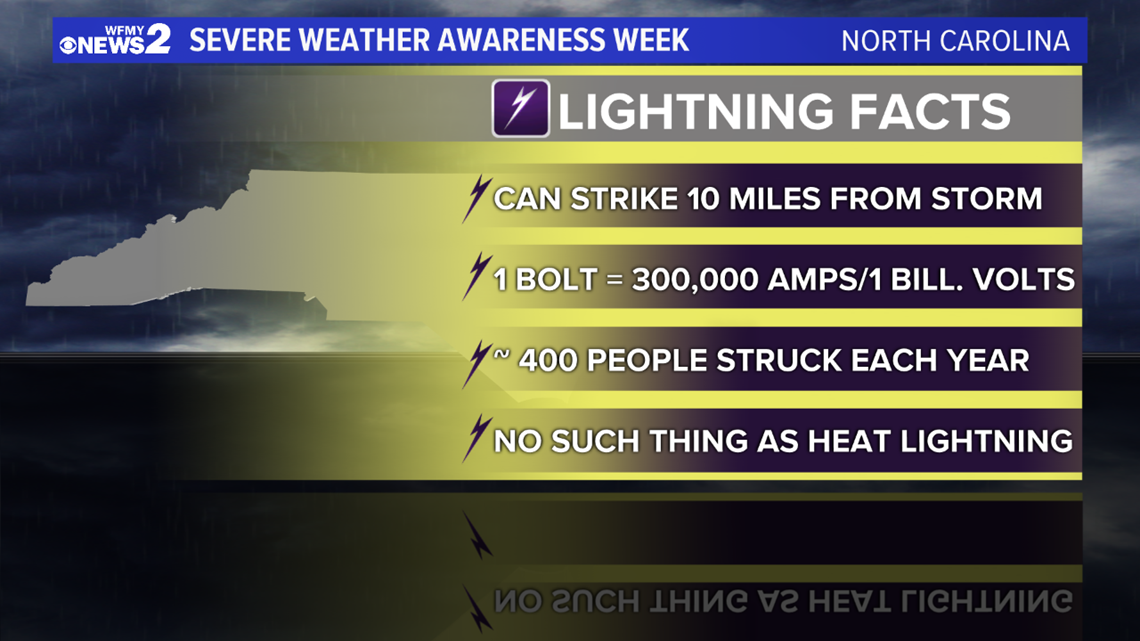
All thunderstorms produce lightning and are dangerous. Lightning often strikes outside the area of heavy rain and may strike as far as 10 miles from any rainfall. Many lightning deaths occur ahead of storms or after storms have seemingly passed. Keep this simple fact in mind: if you can hear thunder, you are in danger. Also, don’t be fooled by blue skies. There is no such thing as “heat lightning.” All lightning comes as a result of a thunderstorm, and if you hear thunder, lightning is close enough to pose an immediate threat to you.

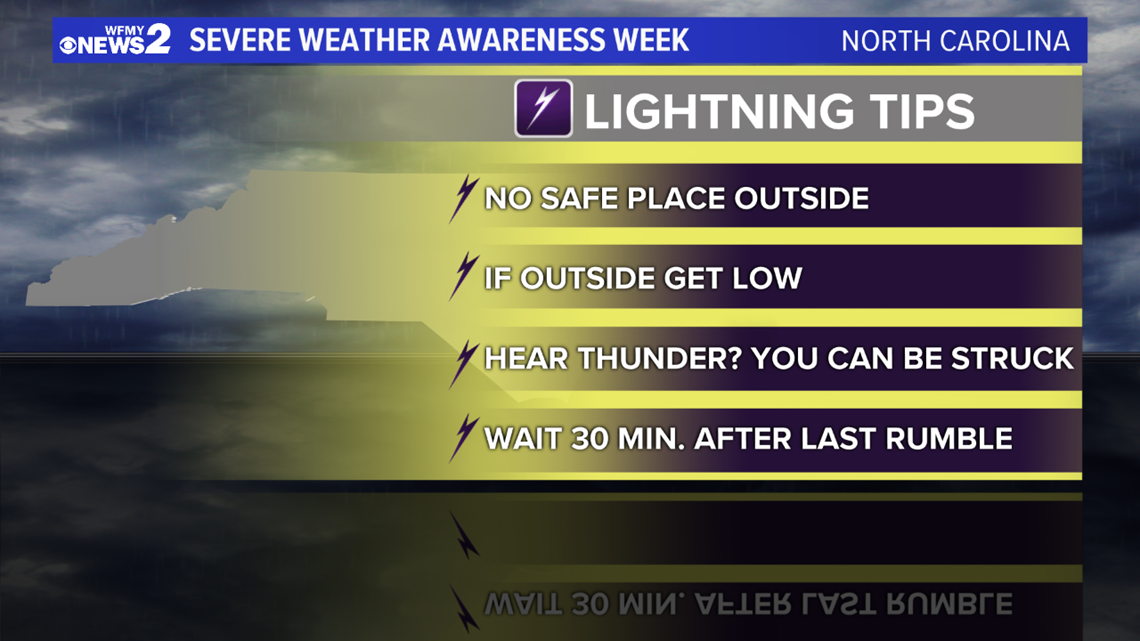
The following lightning safety tips could one day save your life:
- NO PLACE outside is safe when thunderstorms are in the area!
- If you hear thunder, lightning is close enough to strike you.
- When you hear thunder, immediately move to safe shelter. A safe shelter is an enclosed substantial building with electricity or plumbing, such as a home, office building, school restaurant, or a store. Sheds, tents, picnic pavilions, porches, and ball-field dugouts DO NOT offer any lightning protection whatsoever and may actually increase your danger of being struck.
- If no substantial building is available for shelter, enclosed metal-topped vehicles offer protection from lightning, but make sure the windows are in the up position.
- Stay in your safe shelter at least 30 minutes after you hear the last sound of thunder.
- When indoors, stay off corded phones, computers and other electrical equipment that put you in direct contact with electricity. Avoid plumbing, including sinks, baths and faucets. Stay away from windows and doors, and stay off porches. Do not lie on concrete floors, and do not lean against concrete walls.
- If you are caught outside with no safe shelter anywhere nearby, the following actions may reduce your risk:
- Immediately get off elevated areas such as hills, mountain ridges or peaks
- Never lie flat on the ground
- Never shelter under an isolated tree
- Never use a cliff or rocky overhang for shelter
- Immediately get out and away from ponds, lakes and other bodies of water
- Stay away from objects that conduct electricity (barbed wire fences, power lines, windmills, etc.)
The most effective lightning safety action can be found in avoiding the lightning threat altogether. Have a lightning safety plan. If you have outdoor plans, know where you’ll go for safety and how much time it will take to get there. Make sure your plan allows enough time to reach safety. Before going outdoors, check the forecast for thunderstorms. If thunderstorms are in the forecast, consider postponing activities to avoid being caught in a dangerous situation.
Finally, when outdoors, monitor the weather and be sure to look for signs of a developing thunderstorm such as darkening skies, flashes of lightning, or increasing wind. If you hear thunder, even a distant rumble, immediately activate your lightning safety plan and move to a safe place.
Flash flooding in North Carolina usually occurs when a large amount of rain falls in an area over a short period of time. Hurricanes, tropical storms, and ordinary thunderstorms can produce flash flooding. More people die from floods each year than from tornadoes, lightning, or hurricanes.
In the past 10 years, flash flooding has occurred in North Carolina over 1000 times, amounting to damages on the order of hundreds of millions of dollars, and resulting in numerous fatalities. Being prepared and knowing how to stay safe will help you and your loved ones survive a flood.
Knowing your flood risk is the best way to prepare for flooding. Determine if you live in or near locations that are prone to flooding. You can find out if you live in a flood plain by visiting our partners at FEMA at https://msc.fema.gov.
Just six inches of fast-moving water can knock over an adult. Only eighteen inches of flowing water can carry away most vehicles, including large SUVs. It is impossible to tell the exact depth of water covering a roadway or the condition of the road below the water. This is especially true at night when your vision is more limited. It is never safe to drive or walk through flood waters. Any time you come to a flooded road, walkway, or path, follow this simple rule: turn around, don’t drown.

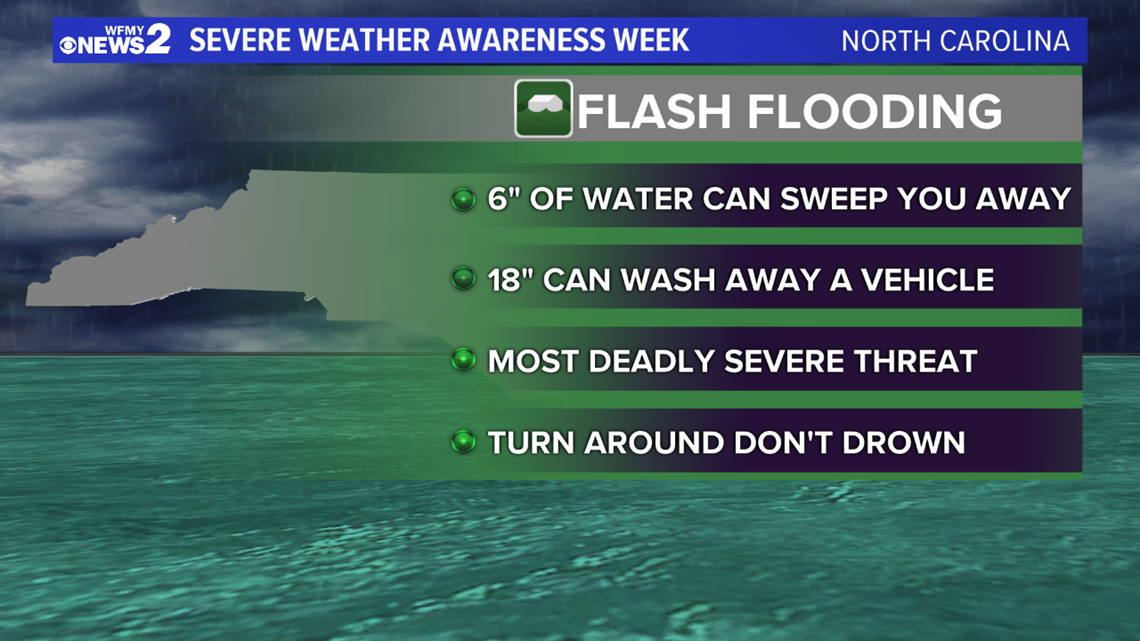
Remember these flash flood safety tips:
If a flash flood warning is issued for your area, or if there is any possibility of a flash flood, move immediately to higher ground. Do not wait for instructions to move.
- Do not walk through moving water. Six inches of moving water can make you fall.
- Do not drive into flooded areas. If floodwaters rise around your car, abandon the car and move to higher ground, when water is not moving or not more than a few inches deep. You and the vehicle can be swept away quickly. If your vehicle is trapped in rapidly moving water, stay in the vehicle. If the water is rising inside the vehicle, seek refuge on the roof.
- Do not disregard or drive around traffic barricades that close off flooded roadways.
- Do not camp or park your vehicle along streams, rivers or creeks, particularly during threatening conditions
► Make it easy to keep up to date with more stories like this. Download the WFMY News 2 App now

